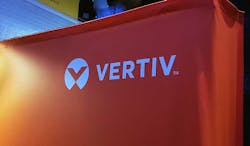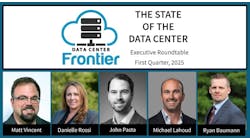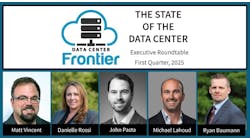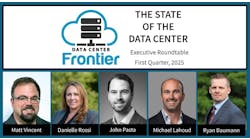Data Center Insights: Peter Panfil of Vertiv
The Data Center Frontier Executive Roundtable features insights from industry executives with lengthy experience in the data center industry. Here’s a look at the insights from Peter Panfil of Vertiv.
Peter Panfil is the Vice President of Global Power at Vertiv. He leads strategic customer development for the Power business and works to apply the latest power and control technology to proven and emerging topologies to provide the availability, scalability and efficiency levels customers demand. Approaching 30 years in critical space he has held executive positions including VP Engineering and VP/GM AC Power prior to his current responsibilities. He is a frequent presenter and spokesperson for industry trade shows, conferences and media outlets serving the IT, facilities and engineering industry.
Here’s the full text of Peter Panfil's insights from our Executive Roundtable:
Data Center Frontier: What will delivery timetables for new data center capacity look like in 2023? Will the combo of supply chain issues, power constraints and staff shortages have an impact on supply?
Peter Panfil: There are many variables that go into data center deployment timetables, but the short answer is that supply chain delays are likely to continue into 2023. All of the issues you mention will have an impact.
There are parts of the world where power limitations are real and can slow or stall new data center construction – sometimes due to government intervention. Staffing is an ongoing issue for our industry and something we are likely to grapple with for years as we adjust to the well-earned retirement of the Baby Boomer generation and new technologies exacerbating a growing skills gap.
The supply chain disruption will prompt change across the industry, with data center organizations working urgently to diversify their supply chains. In practice, that means pursuing in-region suppliers and expertise in the interest of speed while simultaneously leaning on global suppliers with scale who can provide more certainty in terms of product availability. These efforts will continue in 2023 and may extend to investments in new capabilities and acquisitions to facilitate the ability to secure critical components.
Some have already placed their equipment buys for 2023, 2024 and beyond. These advanced purchases are more than just getting an earlier spot in line – they help infrastructure equipment suppliers focus their supply chains on what is specifically needed and when vs buying from a generic planning bill. This improves the likelihood of schedule surety.
All of these issues will accelerate one of the dominant trends in our industry today – the move toward prefabricated modular designs and solutions. This doesn’t eliminate supply chain delays, but it can allow organizations to compress construction timelines by manufacturing systems and components offsite, while site prep is under way. It also can streamline the design phase of most projects by introducing an element of repeatability into the proceedings.
Data Center Frontier: What’s the state of the edge computing market, and how does it compare to your expectations? What are the use cases that are gaining traction?
Peter Panfil: “Robust” may not be a strong enough word. There is massive activity at the edge, and that will continue for the foreseeable future. It has been well documented that the fastest growth in our industry is happening at the edge and in hyperscale, and there are certain fundamentals that will continue to drive that trend.
First and most importantly, compute-heavy, low-latency applications require a dense, sophisticated edge of the network. There are more of those applications than ever before, and more are on the way. Whether we’re talking about consumer applications, such as gaming, streaming video, telehealth or online shopping, or more business-focused applications tied to point-of-sale processing and analytics, artificial intelligence, virtual and augmented reality or machine learning, or addressing a more distributed workforce in a post-Covid world, it all depends on ultra-fast, intelligent, secure networks. These are hybrid networks that incorporate enterprise and cloud as well, but the edge makes it all sing.
In terms of use cases, it’s hard to point to a corner of the economy that isn’t increasingly dependent on the edge of the network. A few areas to watch include (1) artificial intelligence/augmented reality/machine learning – these applications require ultra-fast computing and analytics; (2) telemedicine and telehealth, which were high-potential but low-use niche offerings before Covid but now are significant sources of investment across the healthcare space; and (3) retailers racing to deploy edge computing to enhance the customer experience across all interactions – including in the store – in an effort to hold onto their market share as the on-line marketplace evolves.
Data Center Frontier: How would you assess enterprise IT demand, and what do you see ahead in 2023?
Peter Panfil: We mentioned the growth at the edge and in hyperscale previously, and that’s true, but I think the growth in those areas is creating the perception that the enterprise data center is something of an endangered species. We don’t see it that way at all. Too many organizations still value the security and autonomy of owning their own data center to give up that resource completely. They’re going to maintain or even add enterprise data centers, but those facilities are going to evolve to better serve the organization’s needs.
These new enterprise data centers are the hubs of an increasingly distributed hybrid network that also includes cloud resources and a robust edge of the network. These hubs are and will be higher energy density, more efficient, and highly secure, while housing the organization’s most sensitive data. Depending on the company and the nature of the business, it’s not uncommon to see several of these smaller enterprise facilities deployed as needed in a modified hub-and-spoke network design, similar to the way a telecom central office can support a defined section of a telco network. These are owned facilities that function almost like a multi-access edge computing (MEC) deployment.
Enterprise is also embracing the focus on sustainability. Higher efficiency, less water usage and decarbonization efforts that were thought to be the purview of hyperscalers and MTDCs are just as important if not more at the enterprise level.
The bottom line is this: Yes, the enterprise data center is changing, but it remains a vital part of an increasingly diverse IT mix.
Data Center Frontier: What will be the important themes in sustainability in 2023 for data centers and cloud operators?
Peter Panfil: We’ve reached a point where “sustainability” is likely to be embedded in virtually every conversation in the data center industry and with good reason. Data centers consume significant amounts of energy and water – an estimated 2-3% of global electricity, with forecasts putting that number at 4% by 2030. A single hyperscale facility consumes enough electricity to power up to 37,000 homes, and a data center using evaporative cooling can use 3-5 million gallons of water every day – that’s as much as a city of 30,000 people.
It’s only natural – and prudent – for governments to apply more scrutiny to any industry with that level of resource consumption. Already, in places like Singapore and Ireland, new data center construction is subject to government review and requires compliance with stringent environmental criteria. So, whether data center operators work to reduce their energy consumption and carbon footprint in an effort to address the ongoing climate crisis or they do so to meet anticipated regulatory requirements, the result is the same – sustainability is built into everything they do.
What does that look like in 2023? Let’s start with the low-hanging fruit: High-efficiency power and cooling solutions become a priority, and overlooked efficiency features, such as Dynamic On-Line Mode, will be employed more liberally. New builds are likely to prioritize water-free designs and low-GWP refrigerants. Organizations will embrace modular designs and systems to reduce waste and better match capacity to demand.
We could also see more aggressive decarbonization efforts, including a push to explore alternatives to using diesel. Diesel is a major hurdle to operating carbon free. The industry is looking for other options for extended backup power, including relying on batteries for longer runtimes. Hydrogen fuel cell technologies are evolving and becoming more mature, and we could see fuel cells used as continuous duty batteries as early as 2023.
One last thing on sustainability: This is a difficult subject for the data center industry. Data centers provide immeasurable service to the world and the growth of the industry is unquestionably beneficial, but it’s also true that continued growth creates challenges in terms of energy and water use. We are proud of the proactive steps the industry continues to take to address those challenges, and we look forward to working with our customers and other industry leaders to continue to do everything we can to build a better, more sustainable data center ecosystem going forward.







